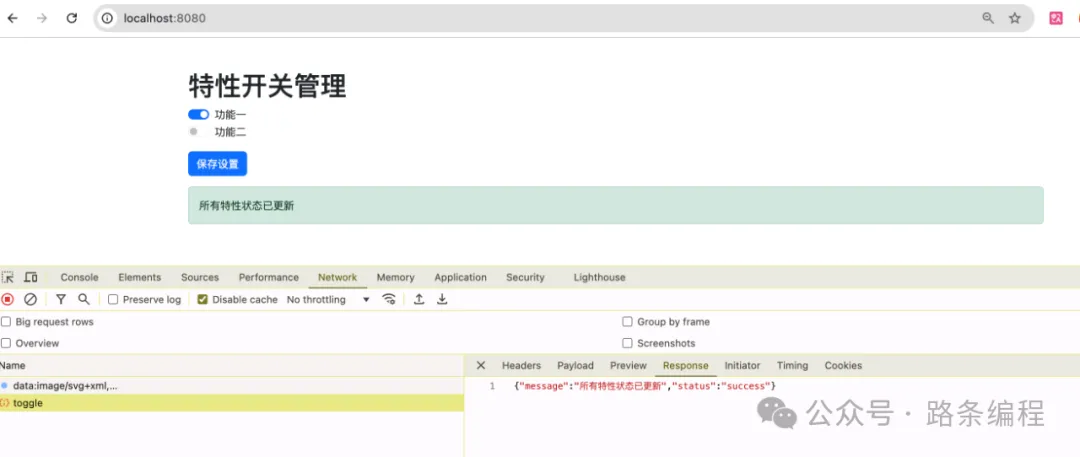在软件开发的持续集成和交付过程中,特性开关(Feature Flags)作为一种非常重要的策略工具,能够为开发团队带来灵活的功能管理方式。通过特性开关,开发者可以在不重新部署应用的情况下,动态地启用或禁用某些功能。这种方法不仅适用于渐进式发布和灰度发布,还能帮助开发者实现 A/B 测试、风险控制以及不同环境下的功能差异化。
传统上,功能的控制往往通过条件语句或分支管理来实现,而特性开关为这一过程提供了更为灵活且细粒度的控制方式。通过引入 Togglz 框架,Spring Boot 应用可以轻松管理特性开关的启用、禁用以及其背后的配置。在本篇文章中,我们将深入探讨如何基于 Togglz 框架,结合 Spring Boot3.3 的 API 和前端 UI 实现特性开关的管理,并使用 MySQL 数据库存储开关状态。
Togglz 框架及其特性
Togglz 是一个用于管理特性开关的轻量级框架,它提供了灵活的 API 和丰富的扩展性,能够帮助开发者在应用程序中快速集成特性开关管理功能。它的主要功能包括:
- 简单的特性开关管理:通过注解和配置,可以快速定义和管理特性开关。
- 多种持久化方式:Togglz 支持将特性开关的状态存储在内存、文件系统或数据库中。
- 支持 Web UI 管理:提供默认的 Web UI,用于在生产环境中实时管理特性开关。
- 集成多种条件控制:通过条件表达式和用户分组,可以针对不同用户或环境启用或禁用特性。
项目网址:https://github.com/togglz/togglz
运行效果:
 图片
图片
若想获取项目完整代码以及其他文章的项目源码,且在代码编写时遇到问题需要咨询交流,欢迎加入下方的知识星球。
本文将基于 Togglz 框架,结合 API 调用实现特性开关的动态管理,并在前端页面通过 AJAX 调用实现特性状态的动态获取与更新。
项目依赖配置
Maven pom.xml 配置
<?xml versinotallow="1.0" encoding="UTF-8"?>
<project xmlns="http://maven.apache.org/POM/4.0.0" xmlns:xsi="http://www.w3.org/2001/XMLSchema-instance"
xsi:schemaLocation="http://maven.apache.org/POM/4.0.0 https://maven.apache.org/xsd/maven-4.0.0.xsd">
<modelVersion>4.0.0</modelVersion>
<parent>
<groupId>org.springframework.boot</groupId>
<artifactId>spring-boot-starter-parent</artifactId>
<version>3.3.3</version>
<relativePath/> <!-- lookup parent from repository -->
</parent>
<groupId>com.icoderoad</groupId>
<artifactId>togglz-flag</artifactId>
<version>0.0.1-SNAPSHOT</version>
<name>togglz-flag</name>
<description>Demo project for Spring Boot</description>
<properties>
<java.version>17</java.version>
<togglz.version>4.4.0</togglz.version>
</properties>
<dependencies>
<!-- Spring Boot 核心依赖 -->
<dependency>
<groupId>org.springframework.boot</groupId>
<artifactId>spring-boot-starter</artifactId>
</dependency>
<!-- Togglz 依赖 -->
<dependency>
<groupId>org.togglz</groupId>
<artifactId>togglz-spring-boot-starter</artifactId>
<version>${togglz.version}</version>
</dependency>
<!-- Spring Boot Starter for JDBC and JPA -->
<dependency>
<groupId>org.springframework.boot</groupId>
<artifactId>spring-boot-starter-data-jpa</artifactId>
</dependency>
<!-- 数据库驱动依赖 -->
<dependency>
<groupId>com.mysql</groupId>
<artifactId>mysql-connector-j</artifactId>
<scope>runtime</scope>
</dependency>
<!-- Spring Boot Web 依赖 -->
<dependency>
<groupId>org.springframework.boot</groupId>
<artifactId>spring-boot-starter-web</artifactId>
</dependency>
<dependency>
<groupId>org.projectlombok</groupId>
<artifactId>lombok</artifactId>
<optional>true</optional>
</dependency>
<!-- Thymeleaf 模板引擎依赖 -->
<dependency>
<groupId>org.springframework.boot</groupId>
<artifactId>spring-boot-starter-thymeleaf</artifactId>
</dependency>
<dependency>
<groupId>org.springframework.boot</groupId>
<artifactId>spring-boot-starter-test</artifactId>
<scope>test</scope>
</dependency>
</dependencies>
<build>
<plugins>
<plugin>
<groupId>org.springframework.boot</groupId>
<artifactId>spring-boot-maven-plugin</artifactId>
</plugin>
</plugins>
</build>
</project>application.yaml 配置
server:
port: 8080
spring:
datasource:
url: jdbc:mysql://localhost:3306/togglz_db
username: root
password: root
driver-class-name: com.mysql.cj.jdbc.Driver后端实现
大家可以通过创建一个实现 TogglzConfig 接口的配置类来定义 FeatureManager 的配置。例如,可以配置它使用 InMemoryStateRepository 或 JDBCStateRepository 来存储特性开关的状态。
正确的 Togglz 配置示例
package com.icoderoad.togglzflag.config;
import javax.sql.DataSource;
import org.springframework.context.annotation.Bean;
import org.springframework.context.annotation.Configuration;
import org.togglz.core.Feature;
import org.togglz.core.manager.FeatureManager;
import org.togglz.core.manager.FeatureManagerBuilder;
import org.togglz.core.manager.TogglzConfig;
import org.togglz.core.repository.StateRepository;
import org.togglz.core.repository.jdbc.JDBCStateRepository;
import org.togglz.core.user.SimpleFeatureUser;
import org.togglz.core.user.UserProvider;
import com.icoderoad.togglzflag.enums.MyFeatures;
/**
* Togglz 的配置类,管理特性开关的配置
*/
@Configuration
public class TogglzFeatureConfig implements TogglzConfig {
private final DataSource dataSource;
public TogglzFeatureConfig(DataSource dataSource) {
this.dataSource = dataSource;
}
@Override
public Class<? extends Feature> getFeatureClass() {
return MyFeatures.class; // 返回定义的特性枚举类
}
@Override
public StateRepository getStateRepository() {
// 使用 JDBC 存储特性状态
return JDBCStateRepository.newBuilder(dataSource).build();
}
@Override
public UserProvider getUserProvider() {
// 定义用户提供者
return () -> new SimpleFeatureUser("admin", true);
}
@Bean
public FeatureManager featureManager() {
return new FeatureManagerBuilder()
.featureEnum(MyFeatures.class) // 绑定特性枚举类
.stateRepository(getStateRepository()) // 设置状态存储库
.userProvider(getUserProvider()) // 设置用户提供者
.build();
}
}通过这样的配置,你可以灵活地管理 Spring Boot 应用中的特性开关,并使用数据库来持久化特性状态。
如果大家想使用内存中的状态存储(InMemoryStateRepository),可以在 getStateRepository() 方法中返回一个简单的内存存储:
@Override
public StateRepository getStateRepository() {
return new InMemoryStateRepository();
}数据库配置
如果你使用 JDBCStateRepository 来持久化特性状态,需要确保你的数据库中有一张存储特性开关状态的表。Togglz 提供了创建这张表的 SQL 脚本:
CREATE TABLE `TOGGLZ` (
`FEATURE_NAME` varchar(100) NOT NULL,
`FEATURE_ENABLED` int(11) NOT NULL,
`STRATEGY_ID` varchar(200) DEFAULT NULL,
`STRATEGY_PARAMS` varchar(2000) DEFAULT NULL,
PRIMARY KEY (`FEATURE_NAME`)
) ENGINE=InnoDB DEFAULT CHARSET=utf8;配置 application.yml
在 application.yml 中配置数据库连接信息:
spring:
datasource:
url: jdbc:mysql://localhost:3306/togglz_db
username: root
password: root
driver-class-name: com.mysql.cj.jdbc.Driver定义特性开关枚举类
在 Togglz 中,特性开关通过枚举类来管理,每个枚举值代表一个开关。该枚举类定义了应用程序中的所有特性开关,并且可以为每个特性开关指定标签和默认状态。
package com.icoderoad.togglzflag.enums;
import org.togglz.core.Feature;
import org.togglz.core.annotation.EnabledByDefault;
import org.togglz.core.annotation.Label;
/**
* 定义应用程序的特性开关
*/
public enum MyFeatures implements Feature {
@Label("功能一")
FEATURE_ONE,
@EnabledByDefault
@Label("功能二")
FEATURE_TWO;
}实现 API 接口
我们创建一个控制器来处理特性开关的查询和更新,通过 RESTful API 实现后端和前端的交互。
package com.icoderoad.togglzflag.controller;
import java.util.HashMap;
import java.util.Map;
import org.springframework.beans.factory.annotation.Autowired;
import org.springframework.web.bind.annotation.GetMapping;
import org.springframework.web.bind.annotation.PostMapping;
import org.springframework.web.bind.annotation.RequestBody;
import org.springframework.web.bind.annotation.RequestMapping;
import org.springframework.web.bind.annotation.RestController;
import org.togglz.core.Feature;
import org.togglz.core.manager.FeatureManager;
import org.togglz.core.repository.FeatureState;
import com.icoderoad.togglzflag.enums.MyFeatures;
@RestController
@RequestMapping("/api/features")
public class FeatureToggleController {
@Autowired
private FeatureManager featureManager;
/**
* 获取当前所有特性状态
*
* @return 特性状态的映射
*/
@GetMapping
public Map<String, Boolean> getFeatures() {
Map<String, Boolean> features = new HashMap<>();
features.put("featureOne", featureManager.isActive(MyFeatures.FEATURE_ONE));
features.put("featureTwo", featureManager.isActive(MyFeatures.FEATURE_TWO));
return features;
}
/**
* 更新特性开关状态
*
* @param featureStates 包含所有特性状态的映射
* @return 更新结果
*/
@PostMapping("/toggle")
public Map<String, String> toggleFeatures(@RequestBody Map<String, Boolean> featureStates) {
try {
for (Map.Entry<String, Boolean> entry : featureStates.entrySet()) {
String featureName = entry.getKey();
boolean enabled = entry.getValue();
Feature feature = getFeature(featureName);
if (feature != null) {
featureManager.setFeatureState(new FeatureState(feature, enabled));
} else {
return Map.of("status", "error", "message", "未找到特性 " + featureName);
}
}
return Map.of("status", "success", "message", "所有特性状态已更新");
} catch (Exception e) {
return Map.of("status", "error", "message", "更新特性状态时发生错误");
}
}
private Feature getFeature(String featureName) {
if ("featureOne".equalsIgnoreCase(featureName)) {
return MyFeatures.FEATURE_ONE;
} else if ("featureTwo".equalsIgnoreCase(featureName)) {
return MyFeatures.FEATURE_TWO;
}
return null;
}
}前端实现
在前端,我们使用 Thymeleaf 渲染数据,并结合 jQuery 和 Bootstrap 实现用户友好的特性开关管理界面。
在 src/main/resources/templates/index.html 文件中使用 Thymeleaf 模板显示配置信息:
<!DOCTYPE html>
<html xmlns:th="http://www.thymeleaf.org">
<head>
<meta charset="UTF-8">
<title>特性开关管理</title>
<link href="https://cdn.jsdelivr.net/npm/bootstrap@5.3.0/dist/css/bootstrap.min.css" rel="stylesheet">
<script src="https://code.jquery.com/jquery-3.6.0.min.js"></script>
</head>
<body>
<div class="container mt-5">
<h1>特性开关管理</h1>
<!-- 特性一开关 -->
<div class="form-check form-switch">
<input class="form-check-input" type="checkbox" id="featureOne">
<label class="form-check-label" for="featureOne">功能一</label>
</div>
<!-- 特性二开关 -->
<div class="form-check form-switch">
<input class="form-check-input" type="checkbox" id="featureTwo">
<label class="form-check-label" for="featureTwo">功能二</label>
</div>
<!-- 保存按钮 -->
<button class="btn btn-primary mt-3" id="saveButton">保存设置</button>
</div>
<script>
// 页面加载时,通过 Ajax 请求获取当前的特性状态
$(document).ready(function () {
$.get("/api/features", function (data) {
// 根据返回的 JSON 数据设置页面开关状态
$('#featureOne').prop('checked', data.featureOne);
$('#featureTwo').prop('checked', data.featureTwo);
});
});
// 点击保存按钮时,发送 Ajax 请求更新特性状态
$('#saveButton').on('click', function () {
const featureOne = $('#featureOne').is(':checked');
const featureTwo = $('#featureTwo').is(':checked');
// 更新功能一状态
$.post("/api/features/toggle", { feature: 'feature-one', enabled: featureOne });
// 更新功能二状态
$.post("/api/features/toggle", { feature: 'feature-two', enabled: featureTwo });
});
</script>
</body>
</html>结论
通过结合 Togglz 框架和 Spring Boot3.3,我们成功实现了基于 API 和 UI 的特性开关管理方案。特性开关管理不仅为应用程序提供了更高的灵活性,还可以帮助团队实现无缝的功能发布。Togglz 的简单集成、持久化配置和丰富的扩展性为特性开关管理提供了理想的解决方案。在未来的工作中,这一方案可以进一步优化,以支持更多特性控制的复杂场景,如按用户组启用、按环境发布等。



































